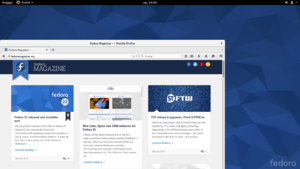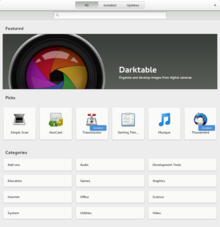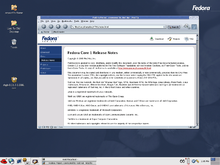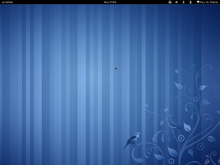Fedora Linux: Difference between revisions
→Releases: Added rawhide as 3 sub heading |
Merged content from Rawhide_(computing) to here. See Talk:Rawhide_(computing) |
| (One intermediate revision by the same user not shown) | |
(No difference)
| |
Revision as of 03:39, 7 December 2015
It has been suggested that Rawhide (computing) be merged into this article. (Discuss) Proposed since May 2014. |
 | |
 Fedora 23 with GNOME 3.18 | |
| Developer | Fedora Project (owned by Red Hat) |
|---|---|
| OS family | Unix-like |
| Working state | Current |
| Source model | Open source |
| Initial release | 6 November 2003[1] |
| Latest release | 23[2] / 3 November 2015 |
| Available in | Multilingual |
| Update method | DNF (PackageKit) |
| Package manager | RPM Package Manager |
| Platforms | i686, x86-64, ARM-hfp, ARM AArch64, IBM Power64, IBM Power64le, IBM Z, MIPS-64el, MIPS-el [3] |
| Kernel type | Linux |
| Userland | GNU |
| Default user interface | GNOME |
| License | Various free software licenses, plus proprietary firmware files.[4] |
| Official website | getfedora |
Fedora /f[invalid input: 'ɨ']ˈdɒr.ə/ (formerly Fedora Core) is an operating system based on the Linux kernel, developed by the community-supported Fedora Project and sponsored by Red Hat. Fedora contains software distributed under a free and open source license and aims to be on the leading edge of such technologies.[5][6]
Features
Fedora has a reputation for focusing on innovation, integrating new technologies early on and working closely with upstream Linux communities.[7] Making changes upstream instead of specifically in Fedora ensures that the changes are available to all Linux distributions.
Fedora has a relatively short life cycle: version X is supported only until 1 month after version X+2 is released and with approximately 6 months between most versions, meaning a version of Fedora is usually supported for approximately 13 months.[8] Fedora users can upgrade from version to version without reinstalling.[9][10]
The default desktop in Fedora is the GNOME desktop environment and the default interface is the GNOME Shell. Other desktop environments, including KDE, Xfce, LXDE, MATE and Cinnamon, are available and can be installed.[11][12]

Fedora uses the RPM package management system.
Security is also important in Fedora with one specific security feature being Security-Enhanced Linux, which implements a variety of security policies, including mandatory access controls, and which Fedora adopted early on.[13]
Software
Fedora comes installed with a wide range of software such as LibreOffice and Firefox. Additional software is available from the software repositories and can be installed using the DNF package manager or GNOME Software.

Additionally, extra repositories can be added to the system, so that software not available in Fedora can be installed.[14]: Section 9.8.1. Software that is not available via official fedora repositories either because they don't meet Fedora's definition of free software or because their distribution may violate US law can be installed using third party repositories. Popular third-party repositories include RPM Fusion free and non-free repositories. Fedora also provides users with an easy-to-use build system for creating their own repositories called Copr.[15]
Flavours
Beginning with Fedora 21, Fedora Linux is available as three distinct primary products: Fedora Cloud, Fedora Server and Fedora Workstation.[16]
- Fedora Workstation – It targets users who want a reliable, user-friendly, and powerful operating system for their laptop or desktop computer. It comes with GNOME desktop environment by default but other desktops can be installed or can be directly installed as Spins ;
- Fedora Server – It targets the Servers and it includes the latest datacenter technologies. This flavour doesn't come with a desktop environment, but one can be installed if necessary.
- Fedora Cloud – Fedora Cloud provides a minimal image of Fedora which includes just the bare essentials. It is meant for deployement in cloud
A Live USB drive can be created using Fedora Live USB creator or the dd command.[14]: Section 3.2. It allows the users to try fedora without making changes to the Hard disk.
Spins
Similar to Debian blends, the Fedora Project also distributes custom variations of Fedora called Fedora spins or editions.[17] These are built with specific sets of software packages, offering alternative desktop environments or targeting specific interests such as gaming, security, design, education,[18] robotics,[19][20] and scientific computing[21] (that includes SciPy, Octave, Kile, Xfig and Inkscape). Fedora spins are developed by several Fedora special interest groups.[17] Fedora also provides a Fedora Atomic Host image for Project Atomic, which is Red Hat's solution for deploying Docker-based containerized applications.[22]
Architectures
Intel i686, AMD x86-64 and ARM-hfp are the primary architecture supported by Fedora.[3] Pidora[23] is a specialized Fedora distribution for the Raspberry Pi. As of release 23, Fedora also supports ARM AArch64, IBM Power64, IBM Power64le, IBM Z, MIPS-64el and MIPS-el as secondary architectures.
History
The Fedora Project was created in late 2003, when Red Hat Linux was discontinued.[24] Red Hat Enterprise Linux was to be Red Hat's only officially supported Linux distribution, while Fedora was to be a community distribution.[24] Red Hat Enterprise Linux branches its releases from versions of Fedora.[25]
The name of Fedora derives from Fedora Linux, a volunteer project that provided extra software for the Red Hat Linux distribution, and from the characteristic fedora hat used in Red Hat's "Shadowman" logo. Warren Togami began Fedora Linux in 2002 as an undergraduate project at the University of Hawaii,[26] intended to provide a single repository for well-tested third-party software packages so that non-Red Hat software would be easier to find, develop, and use. The key of Fedora Linux and Red Hat Linux was that Fedora's repository development would be collaborative with the global volunteer community.[27] Fedora Linux was eventually absorbed into the Fedora Project, carrying with it this collaborative approach.[28]
Before Fedora 7, Fedora was called Fedora Core after the name of one of the two main software repositories - Core and Extras. Fedora Core contained all the base packages that were required by the operating system, as well as other packages that were distributed along with the installation CD/DVDs, and was maintained only by Red Hat developers. Fedora Extras, the secondary repository that had been included since Fedora Core 3, was community-maintained and not distributed along with the installation CD/DVDs. Upon the release of Fedora 7, the distinction between Fedora Core and Fedora Extras was eliminated.[29]
Fedora is a trademark of Red Hat, Inc. Red Hat's application for trademark status for the name "Fedora" was disputed by Cornell University and the University of Virginia Library, creators of the unrelated Fedora Commons digital repository management software.[30] The issue was resolved and the parties settled on a co-existence agreement that stated that the Cornell-UVA project could use the name when clearly associated with open source software for digital object repository systems and that Red Hat could use the name when it was clearly associated with open source computer operating systems.[31]
Linus Torvalds, creator of the Linux kernel, uses Fedora on all of his computers.[32][33]
Releases
The current release is Fedora 23, which was released on 3 November 2015.


| Version[34] | Release[34] | End-of-life[35] | Kernel[36][a] | GNOME[36] |
|---|---|---|---|---|
| 1 (Yarrow) | 2003-11-06 | 2004-09-20 | 2.4.22 | 2.4 |
| 2 (Tettnang) | 2004-05-18 | 2005-04-11 | 2.6.5 | 2.6 |
| 3 (Heidelberg) | 2004-11-08 | 2006-01-16 | 2.6.9 | 2.8 |
| 4 (Stentz) | 2005-06-13 | 2006-08-07 | 2.6.11 | 2.10 |
| 5 (Bordeaux) | 2006-03-20 | 2007-07-02 | 2.6.15 | 2.14 |
| 6 (Zod) | 2006-10-24 | 2007-12-07 | 2.6.18 | 2.16 |
| 7 (Moonshine) | 2007-05-31 | 2008-06-13 | 2.6.21 | 2.18 |
| 8 (Werewolf) | 2007-11-08 | 2009-01-07 | 2.6.23 | 2.20 |
| 9 (Sulphur) | 2008-05-24 | 2009-07-10 | 2.6.25 | 2.22 |
| 10 (Cambridge) | 2008-11-25 | 2009-12-18 | 2.6.27 | 2.24 |
| 11 (Leonidas) | 2009-06-09 | 2010-06-25 | 2.6.29 | 2.26 |
| 12 (Constantine) | 2009-11-17 | 2010-12-02 | 2.6.31 | 2.28 |
| 13 (Goddard) | 2010-05-25 | 2011-06-24 | 2.6.33 | 2.30 |
| 14 (Laughlin) | 2010-10-29 | 2011-12-08 | 2.6.35 | 2.32 |
| 15 (Lovelock) | 2011-05-24 | 2012-06-26 | 2.6.38 | 3.0 |
| 16 (Verne) | 2011-11-08 | 2013-02-12 | 3.1 | 3.2 |
| 17 (Beefy Miracle) | 2012-05-29 | 2013-07-30 | 3.3 | 3.4 |
| 18 (Spherical Cow) | 2013-01-15 | 2014-01-14 | 3.6 | 3.6 |
| 19 (Schrödinger's Cat) | 2013-07-02 | 2015-01-06 | 3.9 | 3.8 |
| 20 (Heisenbug) | 2013-12-17 | 2015-06-23 | 3.11 | 3.10 |
| 21[38] | 2014-12-09 | 2015-12-01 | 3.17 | 3.14 |
| 22 | 2015-05-26 | 2016-07-19 | 4.0 | 3.16 |
| 23 | 2015-11-03 | 2016-12-20 | 4.2 | 3.18 |
| 24 | 2016-06-21 | 2017-08-08 | 4.5 | 3.20 |
| 25 | 2016-11-22 | 2017-12-12 | 4.8 | 3.22 |
| 26 | 2017-07-11 | 2018-05-29 | 4.11 | 3.24 |
| 27 | 2017-11-14 | 2018-11-30 | 4.13 | 3.26 |
| 28 | 2018-05-01 | 2019-05-28 | 4.16 | 3.28 |
| 29 | 2018-10-30 | 2019-11-26 | 4.18 | 3.30 |
| 30 | 2019-05-07 | 2020-05-26 | 5.0 | 3.32 |
| 31 | 2019-10-29 | 2020-11-24 | 5.3 | 3.34 |
| 32 | 2020-04-28 | 2021-05-25 | 5.6 | 3.36 |
| 33 | 2020-10-27 | 2021-11-30 | 5.8 | 3.38 |
| 34 | 2021-04-27 | 2022-06-07 | 5.11 | 40 |
| 35 | 2021-11-02 | 2022-12-13 | 5.14 | 41 |
| 36 | 2022-05-10 | 2023-05-16 | 5.17 | 42 |
| 37 | 2022-11-15[39] | 2023-12-05[40] | 6.0 | 43 |
| 38 | 2023-04-18[41] | 2024-05-21[41] | 6.2 | 44 |
| 39 | 2023-11-07[40] | 2024-11-12[40] | 6.5 | 45 |
| 40 | 2024-04-23[42] | 2025-05-13[42] | 6.8 | 46 |
| 41 | 2024-10-15[43] | [to be determined] | [to be determined] | [to be determined] |
Legend: Old version Older version, still maintained Latest version Latest preview version Future release | ||||

Rawhide
Rawhide is the development tree for the Fedora. This is a copy of complete Fedora distribution where new software is added and tested, before inclusion in a later stable release. As such, Rawhide is often more feature rich than the current stable release. In many cases, the software is made of CVS, Subversion or Git source code snapshots which are often actively developed by programmers. Although Rawhide is targeted at advanced users, testers, and package maintainers, it is capable of being a primary operating system. Users interested of the Rawhide branch often update on a daily basis and help troubleshoot problems.[44] Rawhide users doesn't have to upgrade between different versions as it follows Rolling release update model.
Derivatives
Some notable Fedora derivative Linux distributions are:[45]
- Korora – a complete and easy to use system for general computing that “just works” out of the box.
- OLPC OS – for the One Laptop per Child laptops.
- Red Hat Enterprise Linux – enterprise Linux offering from Red Hat, which branches from the current Fedora baseline.
See also
References
- ^ Nottingham, Bill (6 November 2003). "Announcing Fedora Core 1". Fedora Project announce (Mailing list). Retrieved 18 May 2014.
{{cite mailing list}}: Unknown parameter|mailinglist=ignored (|mailing-list=suggested) (help) - ^ "https://fedoramagazine.org/fedora-23-released/". Fedora Magazine. 3 November 2015. Retrieved 28 November 2015.
{{cite web}}: External link in|title= - ^ a b "Architectures". Fedora Project. Retrieved 2 December 2015.
- ^ "Frequently Asked Questions about Fedora Licensing". Fedora Project. Retrieved 27 March 2014.
- ^ Spevack, Max (18 August 2006). "Fedora Project Leader Max Spevack Responds". Slashdot. Retrieved 17 December 2006.
- ^ "Objectives". Fedora Project. Retrieved 12 February 2007.
- ^ "Staying close to upstream projects". Fedora Project. Retrieved 24 May 2015.
- ^ "Fedora Release Life Cycle". Fedora Project. Retrieved 25 March 2014.
- ^ "FedUp". Fedora Project. Retrieved 25 March 2014.
- ^ "Fedora 23 Release Notes: 3.2.4. System Upgrades with DNF". Fedora Project. Retrieved 1 October 2015.
- ^ Linder, Brad (29 May 2012). "Fedora 17 now available for download". Liliputing. Retrieved 30 May 2012.
- ^ Brodkin, Jon (15 January 2013). "How to install the MATE and Cinnamon desktops on Fedora 18". Ars Technica. Retrieved 15 January 2013.
- ^ Spenneberg, Ralf (August 2006). "Security Hardened - Mandatory Access Control with SELinux" (PDF). Linux Magazine, Issue 69. Linux New Media USA. Retrieved 7 October 2007.
- ^ a b "Fedora 20 Installation Guide". Fedora Project. Retrieved 19 May 2014.
- ^ "Fedora Copr". Fedora Project. Retrieved 27 March 2014.
- ^ "Fedora 21 Release Notes: 2. Fedora Products". Fedora Project. Retrieved 30 October 2015.
- ^ a b "Fedora Spins". Fedora Project. Retrieved 3 February 2014.
- ^ "Sugar-on-a-Stick Linux". Fedora Project.
- ^ "Fedora Robotics Edition". Fedora Project. Retrieved 18 March 2015.
- ^ "Fedora Robotics Wiki". Fedora Project. Retrieved 18 March 2015.
- ^ "Fedora Scientific". Fedora Project. Retrieved 18 March 2015.
- ^ "Project Atomic: Create and Run Applications in Linux Containers". Project Atomic. Retrieved 22 September 2015.
- ^ "Pidora - Raspberry Pi Fedora Remix". pidora
.ca. Retrieved 18 March 2015. {{cite web}}: External link in|publisher= - ^ a b Johnson, Michael K. (22 September 2003). "Fedora Project: Announcing New Direction". Fedora development (Mailing list). Retrieved 18 October 2007.
{{cite mailing list}}: Unknown parameter|mailinglist=ignored (|mailing-list=suggested) (help) - ^ Burke, Tim (August 2006). "The Fedora Project and Red Hat Enterprise Linux, part 4". Red Hat Magazine, Issue #22. Red Hat. Retrieved 18 October 2007.
- ^ "Warren Togami". fedoraproject.org.
- ^ Barr, Joe (1 October 2003). "Warren Togami on the new Fedora Project". Linux.com. Retrieved 9 February 2010.
- ^ Togami, Warren (February 2006). "Why Fedora?" (ODP). Retrieved 30 April 2011.
- ^ "Releases/7". Fedora Project. Retrieved 27 February 2014.
- ^ Becker, David (21 November 2003). "Red Hat, researchers in name tiff". CNET News. CBS Interactive Inc. Retrieved 3 February 2014.
- ^ "Fedora Repository Project History". Retrieved 3 February 2014.
- ^ "Interview with Linus Torvalds from Linux Format 163". TuxRadar. Linux Format. 29 November 2012. Retrieved 4 August 2015.
- ^ Torvalds, Linus (30 December 2014). "The merge window being over, and things being calm made me think I should try upgrading to F21". Google+. Retrieved 3 May 2015.
- ^ a b "Releases/HistoricalSchedules". Fedora Project. Retrieved 11 August 2015.
- ^ "End of life". Fedora Project. Retrieved 11 May 2014.
- ^ a b "Fedora Linux". DistroWatch. Retrieved 15 May 2014.
- ^ "KernelRebases". Fedora Project. Retrieved 18 May 2014.
- ^ Boyer, Josh (2 October 2013). "Release Name process ended". Fedora community advisory board mailing list. Retrieved 11 May 2014.
- ^ "Fedora Linux 37 Schedule". Fedora Project.
- ^ a b c "Fedora Linux 39 Schedule". Fedora Project.
- ^ a b "Fedora Linux 38 Schedule". Fedora Project.
- ^ a b "Fedora Linux 40 Schedule". Fedora Project.
- ^ "Fedora Linux 41 Schedule". Fedora Project.
- ^ https://fedoraproject.org/wiki/Releases/Rawhide?rd=Rawhide#Using_Rawhide
- ^ "List of Fedora derived Linux distributions". DistroWatch. Retrieved 11 May 2014.
External links
- Articles to be merged from May 2014
- Ill-formatted IPAc-en transclusions
- Use dmy dates from August 2011
- Fedora Project
- IA-32 Linux distributions
- Linux kernel-based operating systems
- RPM-based Linux distributions
- X86-64 Linux distributions
- Operating systems that offer the LXDE desktop
- Operating systems that offer the Xfce desktop
